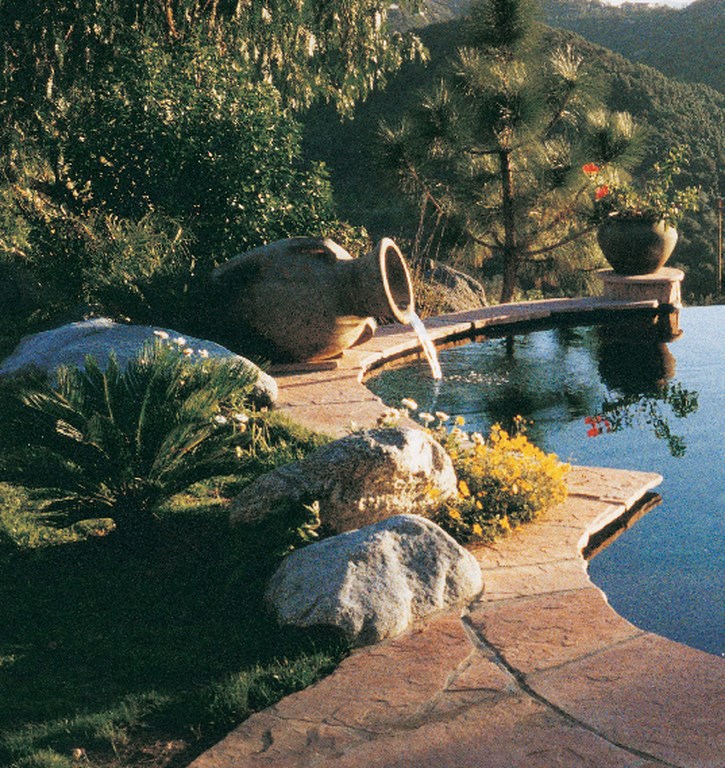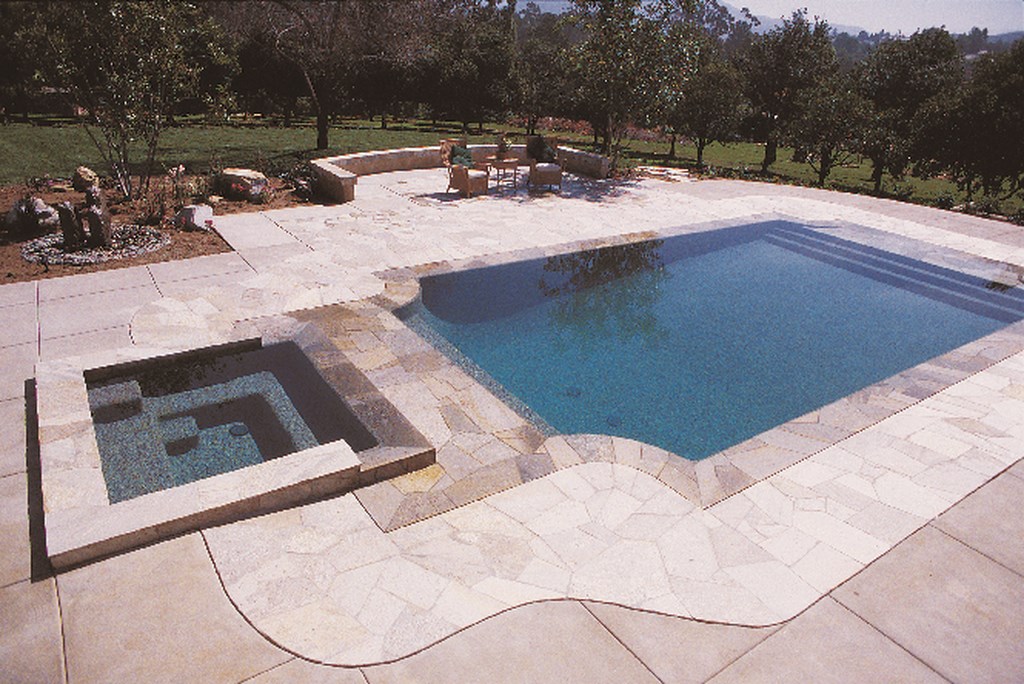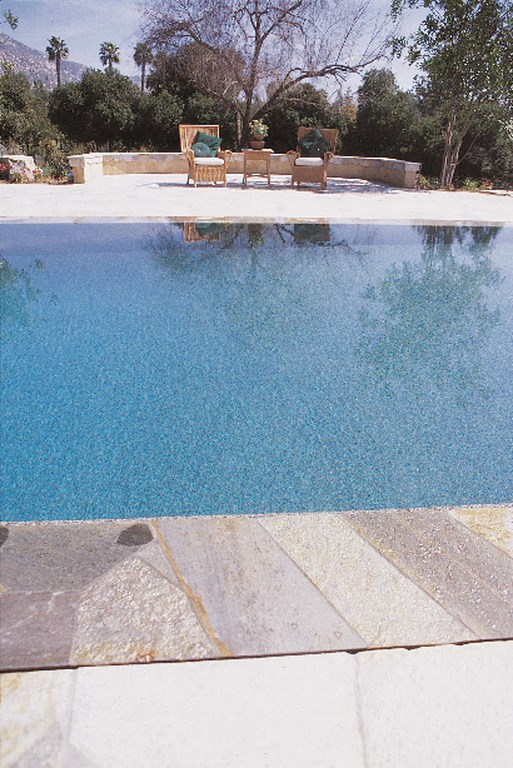Gaining an Edge

I’ve spent a lot of time in the past few years thinking about the things that generate the most interest in what we do as pool builders – and even more time turning those thoughts into designs and effects that meet my customers’ desires.
Once I started down this path, there was no way to turn back: There’s a market out there at the high end that most pool builders never even approach, and breaking through with these clients takes persistence, skill and talent. As important, it also takes a willingness to stop looking at pools, spas and waterfeatures in the context of traditions and conventions that just don’t line up with the needs or expectations that these customers at the highest levels have these days.
These are customers who won’t settle for the ordinary. They won’t accept plans that stick spas up 18 inches above the pool for no reason, then back it up with big piles of rock with water spitting out of the top. These are fatally flawed designs, no matter how well you build pools or what you’re able to charge for them, and these customers won’t give you a second look.
In my case, initial access to this high-grade market came through the work I’d done with vanishing-edge designs of all sizes and descriptions. I’ve long been a firm believer in the possibilities presented by vanishing edges – and I’ve built lots of them all over the world. Recently and in ways that have made my customers happy, I’ve found that some of the characteristics of these pools are leading me in new design directions – and, as you’ll see in this article, to rethinking the way I treat edges in my watershapes.
A Different Language
When I want inspiration, I usually find myself looking toward Europe (and France in particular) for design ideas. There’s an elegance and a sense of timelessness in what they do that can teach all of us lessons.
This particular pool is a tribute to pools you’d see in the south of France. First of all, the view from the property is reminiscent of the sort of prospects you find there, with long vistas of rolling hills and green, haze-shrouded canyons. The use of the oversized urn as a waterspout is very much in keeping with French design principles, and even the landscaping fits with the models I had in mind.
The feature that makes this project so effective, in my opinion, is the way the vanishing-edge detail gave us the opportunity to raise the water level with respect to the deck – about three inches of difference rather than the six required to make a skimmer work without flooding. And we enhanced the effect by hanging the coping over the waterline tile: This edge detail enhances the impact of the higher water level and also minimizes the sharpness of the edges.
A note on the urn: The fact that it pours a steady, coherent stream of water from a reasonable height minimizes the extent to which it creates surface ripples that would disrupt the vanishing edge.
Double Delight
In this case, the use of vanishing edges on both long sides of the pool – one facing the house, the other disappearing over the golf course – enabled us to bring the water level basically even with the decking leading out from the home. In addition, it let us lower the profile of the raised decking we used to frame the spa at one end and the pedestal at the other.
This is a key to a lot of what we’re doing with edges: If a vanishing-edge detail frees you of the need to install a skimmer (and that’s not always the case!), there’s no good reason to think in terms of placing decks the standard six inches above the waterline.
  |
In this case, we’ve also pushed the coping out over a dark waterline tile in a way that masks the profile of deck and waterline.
Maybe it had to do with the El Niño storms and the fact that the downpours filled pools up way over the usual level, but I’ve found that my customers truly love this look – and I find myself looking for new ways to deliver it to them.
Zero-Depth Access
Beach entries are among the most popular of all edge details, which is interesting because what they really do is break down the edge and make it disappear completely – in a way, the ultimate extension of the water/deck-level relationships I’ve been exploring lately.
This is a case where the materials you use have to be part of an overall program, because certain materials simply don’t work when exposed to pool water for an extended period. For example, most common sandstones don’t hold up well. What you need is a material that is basically impermeable, like granite or quartzite.
These edge treatments add a whole new dimension to the uses my customers make of their pools, usually as a space for sunning. But most important from my perspective is that it funnels access to the pool where you most want that access to occur.
In this case, there is no defined access point on the opposite side of the pool, where we set the vanishing edge detail: The sweep of the deck leads bathers around to the beach entry or to the spa – where they can see the vanishing edge to best effect – and we’ve set things up deliberately to limit access at other points. In this case, we totally blocked access to one side of the pool by putting up a barrier of rocks and plantings. The objective here was to create the impression of a duck pond – and that just wouldn’t have worked if the pool had been surrounded entirely by the standard ribbon of decking six inches above the waterline.
A New Angle
I’m not certain why pool designers have felt so limited by a sense that pool edges are supposed to be vertical, but I’ve taken to working with beveled edges on several of our pools and spas. I love the look – and so do my customers.
All of the work I do takes precision – especially recently, because I’ve been getting away from “naturalistic” shapes and working more with sharp lines, angles and defined radiuses. But these beveled edges take special care and have forced me to think and work things through in three dimensions in sharper terms than I ever did before.
In this case, the Sedona sandstone wouldn’t hold up under water, so the spillway is lined with granite and the bevels stand several inches above the waterline. In other cases, the materials chosen by the customer will allow the bevels to reach below the waterline, producing remarkable edge effects. (See under the heading “Elevations with Style,” below.)
This project is in the backyard of a Santa Fe-style house, and I based the pool’s perimeter on shapes, contours and textures the owners put into their house and its furnishings. I do this a lot: I try to make my pools a direct extension of the house and the interior space. The last thing I’d want to do is put a kidney or a lazy L in this space. (See the sidebar just below for more on this subject.)
This is a case where the deck and water levels are at the conventional six-inch difference, but I’ve done what I can to change the vertical profile by projecting the coping stones over a waterline I’ve made as dark as I can.
|
Inside Out Among my customers, designs that really work are the ones that have continuity with their surroundings. In other words, it’s not enough to use a pyramid detail or raise the water level or draw up a vanishing edge: What you do in a customer’s backyard must fit in with its surroundings and make sense as part of an overall design for the home. When I do a pool design, the first question I ask myself is, “Are there elements on the exterior of this home that I need to pick up in the pool design?” If there’s nothing there – say you’re called to a simple tract house – you need to look at the interior and how the owners have decorated it to see which elements you can carry outside to your pool design. That’s what we want to do: Make the pool an extension of the house rather than a random set of afterthoughts. This sort of design continuity is too often overlooked in pool design. With a custom home, the owners have generally used architects, builders and landscape architects whose work they admire – so why would they call in a pool salesperson who comes in and does the pool design free of charge? Customer expectations of pool builders are rising higher and higher all the time. As I’ve worked my way into this higher-end market, I’ve learned first-hand that credibility is the key when it comes to meshing with other design trades. I may be arrogant when it comes to my pool designs, but I have the talent and skill to back it up, and I’ve earned the respect of those other trades. I now work with architects and landscape firms that are at the top of their fields, and they defer to me when it comes to my ideas and designs because they know I can answer questions they can’t. And that’s usually true of the best people in any trade: They know when to ask questions, and they know when to accept the answers they get. Once you have that sort of skill and the confidence to press the limits, you open things up and find yourself with lots of options. You find yourself wondering why we all tend to think in terms of 15-by-30 pools, 20-by-40 pools, kidney-shaped pools – and you start to break down the conventional thinking in creative, innovative ways. Why, for instance, do we drop so many freeform pools into square backyards behind linear houses? And as long as what you do fits in with the surroundings – the style of the house, the look of the interiors – then you can start to play with the possibilities. One thing we do without exception is play with angles and how the pool aligns with the house. Why are so many set up with a long axis parallel to the back of the house? We’ve gotten past these questions, and now we focus on how we make the transition from the home to the pool. We do it with materials, we do it with balance – and we do it as much as possible by forgetting about the way most pools look. The unusual angles of the pool under the heading “A New Angle” (above), for example, are an expression of the shapes we found with the home. All those angles may seem strange out of context, but they’re just right in that backyard – and they work much better than would a 20-by-40 pool with standard coping, a raised spa and a three-foot ribbon of deck. – S.P. |
Breaking Down Barriers
This is a case where form and function come together beautifully. The owner, a former competitive swimmer, wanted a lap pool – but with something special besides.
The site was bordered by a low retaining wall. By raising the water level above the deck level in the pool and creating what is basically a full-perimeter spillway over a granite beam, the retaining wall has been completely masked from view and the pool, spa and swim-up bar all seem like free-flowing extensions of the house and patio.
Everything is sharp and angular, but the edge treatment softens the lines – and the white noise from the spillover and spa dam adds a nice touch.
With an edge like this, it’s obviously critical to get things right, including the slight tilting of the top surfaces of the granite toward the pool to keep the entire edge wet and the flow even. In this case, the surge is handled by the space set up as a swim-up bar, so the gutter around the rest of the raised edge is narrow and basically hidden.
Set Like a Jewel
This is a renovation project where the customer’s desire lined up perfectly with what we wanted to do.
The original pool had been completely conventional. By setting a new shell inside the old one, we were able to create a full-perimeter vanishing edge that brings the water level right up to the original deck level.
The old pool had walls that sloped fairly dramatically toward the floor. We used this to our advantage, raising the water level above the old pool’s walls and making the V-shaped notch between old and new walls into a gutter system for the vanishing edge. We simply moved the new wall in a little at one end to create a surge tank capable of handling the flow.
This project doesn’t seem all that spectacular, but it’s led us to take the full-perimeter concept a couple steps farther in the project seen under the “Changing Perspectives” heading, below.
Elevations with Style
I’ve long advised other builders to avoid elevations unless there’s a good reason to design one. I also believe that we can all stand to be more subtle and try to get away from sharp, vertical elevations.
In my own work, for example, I’ve been using pyramids more and more often as a way to soften edges. I’ve never seen this edge detail in anyone else’s work. Besides offering a nice visual effect from outside the pool, I’m convinced that this approach helps to eliminate the sense of claustrophobia some people get in normal pools where they’re hemmed in by six-inch-high vertical barriers. A lot of that feeling evaporates when you rethink the angles of the walls – or fold them back completely.
Obviously, the degree of difficulty starts going up, but it’s not necessarily because doing this is hard. Instead, it’s just different, and everyone has to be re-schooled – your steel crew, your plumbers, your guniters, your tilers. If you don’t have a vision and can’t be responsible for keeping everything straight, these sorts of special edge treatments can turn into butchered-up messes. But despite the fact that doing things this way is more complicated, I think it’s a wonderful way to handle elevation changes.
This is a good example of the pyramid detail: The water line is right at the base of the elevation change. In this case, the material is San Francisco granite, and it can stand up under water without deteriorating.
Changing Perspectives
This recently completed project carries all of the concepts I’ve described here about playing with the relationships between water and deck level to a logical conclusion. In fact, I think it takes the discussion about as far as it can go.
In this case, the water level of this full perimeter, vanishing edge pool is right at deck level, with the water spilling over into a one-inch-wide slot stretching all the way around the pool. To reach the slot, the water flows across a slightly submerged band of “coping” – a highly unusual frame-like break between the span of dry decking and the body of water.
This approach called for an extraordinarily high degree of precision in layout and execution – in both aesthetic and hydraulic terms. The aesthetic challenge comes from the way this particular edge treatment calls attention to itself and would reflect any significant errors of alignment. And given the narrowness of the slot, keeping the entire perimeter wet isn’t so much a matter of adjusting the flow, but rather of a balanced hydraulic system matched up with some impressively precise masonry work.
It’s a killer look, and another case in which playing with the relationship between deck and water levels creates awesome effects.
Skip Phillips is president of Questar Pools, a high-end swimming pool design-and-build firm based in Escondido, Calif. He started his business in 1975 as a service/supply/repair operation, moving quickly into renovations and new construction. Now a veteran designer and builder of high-end, custom swimming pools, Phillips has won more than 100 local, national and international design awards. His reputation is tied closely to hillside pools featuring vanishing-edge designs; he is one of only two U.S. instructors currently teaching classes on vanishing-edge pools and has written and participated in numerous magazine articles on the subject. Phillips is a past president of the National Spa & Pool Institute and recently co-founded the Genesis 3 Design Group.




















